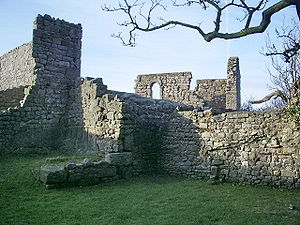
St Patrick's Chapel, Heysham
Encyclopedia


St Peter's Church, Heysham
St Peter's Church, Heysham, is in the village of Heysham, Lancashire, England. It has been designated by English Heritage as a Grade I listed building, It continues to be in use as an active Anglican parish church in the deanery of Lancaster, the archdeaconry of Lancaster and the diocese of...
, Lancashire
Lancashire
Lancashire is a non-metropolitan county of historic origin in the North West of England. It takes its name from the city of Lancaster, and is sometimes known as the County of Lancaster. Although Lancaster is still considered to be the county town, Lancashire County Council is based in Preston...
, England . It is a Grade I listed building and a Scheduled Ancient Monument.
Description
The ruin dates from the 8th or 9th century, and is built of sandstoneSandstone
Sandstone is a sedimentary rock composed mainly of sand-sized minerals or rock grains.Most sandstone is composed of quartz and/or feldspar because these are the most common minerals in the Earth's crust. Like sand, sandstone may be any colour, but the most common colours are tan, brown, yellow,...
rubble
Rubble
Rubble is broken stone, of irregular size, shape and texture. This word is closely connected in derivation with "rubbish", which was formerly also applied to what we now call "rubble". Rubble naturally found in the soil is known also as brash...
. The plan is a plain rectangle measuring 27.5 feet (8 m) by 9 feet (3 m). Consolidation work was carried out in 1903 using stone tiles. Most of the south wall, the east gable wall, and the east part of the north wall are still present. The south wall contains a doorway with long-and-short jambs
Door jamb
A doorjamb is the vertical portion of the frame onto which a door is secured. The jamb bears the weight of the door through its hinges, and most types of door latches and deadbolts extend into a recess in the doorjamb when engaged, making the "true" and strength of the doorjambs vitally important...
and an arch with concentric grooves. Near the chapel is a group of six rock-cut tombs and a separate group of two rock-cut tombs. Each group is listed Grade I and each tomb has an associated socket probably intended for a timber cross.

